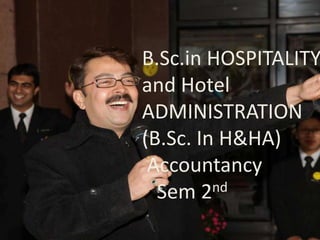
Income & revenue expanditure
- 1. B.Sc.in HOSPITALITY and Hotel ADMINISTRATION (B.Sc. In H&HA) Accountancy Sem 2 nd
- 3. CLASSIFICATION OF EXPENDITURE Expenditure can be classified into three categories: Capital Expenditure Revenue Expenditure Deferred Revenue Expenditure Capital expenditure: Capital expenditure is that expenditure which result in acquisition of an asset and can later be sold and converted into cash or which results in an increase in the earning capacity of a business. Another test of a capital expenditure is that the benefit of such expenditure lasts for a long period of time.
- 4. Following are some of the examples of capital expenditure: a) Cost of fixed or permanent assets, such as lands, buildings, machinery, patent rights, vehicles, furniture, loose tools, etc., purchased for use in business are capital expenditure. b) Cost of additions or extensions to existing fixed assets, such as costs of addition to machinery, costs of extensions to buildings, etc., are capital expenditure. c) Any expenditure incurred in connection with the acquisition, (i.e., purchase) of fixed assets is a capital expenditure. For example, legal charges and brokerage paid for acquiring land and buildings are capital expenditure. d) Any expenditure incurred in bringing the assets purchased to the business is a capital expenditure. For example, carriage or freight paid for bringing the machinery purchased is a capital expenditure.
- 5. e) Any expenditure incurred in installing the fixed assets is a capital expenditure. For example, charges incurred on the erection of machinery or charges incurred in the fixing of fans are capital expenditure. f) Any expenditure incurred on the alternations and improvements of existing fixed assets so as to increase their income earning capacity is treated as a capital expenditure. For example, a large amount spent on a useless machine so as to make useful is treated as capital expenditure because it increases the revenue earning capacity of the fixed asset. g) Development expenditure (i.e., amount spent on an asset before it has started yielding) is a capital expenditure. For instance , amount spent on a tea estate or rubber estate before, it has started yielding is a capital expenditure.
- 6. REVENUE EXPENDITURE: An expenditure that arises out of and in the course of regular business transactions of a concern is termed as revenue expenditure. In other words, expenses whose benefit expires within the year of expenditure and which are incurred to maintain the earning capacity of existing assets are termed as revenue expenditure. These expenses are recurring in nature. Following are few examples of revenue expenditure: a) Cost of goods purchased for resale is revenue expenditure. b) Expenses, such as carriage, freight, etc., incurred in bringing the goods purchased to the place of business are revenue expenditure. c) Cost of material consumed in the manufacture of goods for meant for resale is revenue expenditure.
- 7. d) Expenses incurred in manufacturing goods for resale are revenue expenditure, e.g., wages, power, factory rent, insurance, factory heating, etc. e) Expenses incurred for the day-to-day management of the business are revenue expenditure, e.g., salaries, rent, law charges, bank charges, printing and stationery, postage and telegrams, etc. f) Expenses incurred for selling the products are revenue expenditure, e.g., advertisement, commission paid, carriage outward, bad debts, etc. g) Any expenditure which is incurred for maintaining the fixed assets in good working order or condition is revenue expenditure, i.e., repairs, replacements and renewals of fixed assets. h) Interest on loan borrowed, interest on deposits accepted, interest on capital, discount allowed, etc., are revenue expenditure.
- 8. DIFFERENCES BETWEEN CAPITAL EXPENDITURE AND REVENUE EXPENDITURE S. No. CAPITAL EXPENDITURE REVENUE EXPENDITURE 1. Capital expenditure is incurred Revenue expenditure is incurred for acquiring fixed assets intended for acquiring or producing goods for use in the business, and not for meant for sale. resale. 2. Capital expenditure is incurred Revenue expenditure is incurred for extending or improving the for maintaining the fixed assets existing fixed assets. in a good working order. 3. Capital expenditure adds to the Revenue expenditure does not revenue earning capacity of a add to the revenue earning concern. capacity of a concern. 4. The benefits of capital expenditure Revenue expenditure will extend to more than one year. decrease the value of net assets. 5. Capital expenditure will increase The benefit of revenue the value of net assets. expenditure is confined to only 6. Capital expenditure is non- one year. recurring. Revenue expenditure is 7. Capital expenditure will go to the recurring. Balance sheet. Revenue expenditure will go to the Trading Account or Profit and Account.
